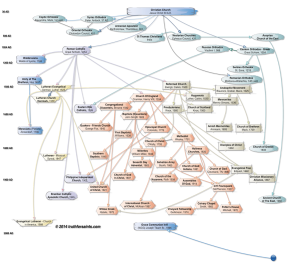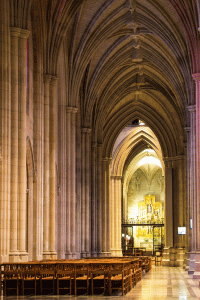FEATURED CONTENT: Is Doctrinal Unity Possible? (Watchman Magazine)
 Denomination Family Tree
Denomination Family Tree
Truth for Saints traces the roots of all denominations in a format familiar to everyone who has explored their personal genealogies. This family tree includes seven branches of Christian denominations — Oriental Orthodox, Roman Catholic, Eastern Orthodox and four Protestant branches. Truth for Saints also created a handy drop-down menu with profiles of major denominations, including the dates they were founded. Another section of the site focuses on competing religions.
Denominational Chart
This chart from the Gordon-Conwell Theological Seminary identifies denominations based on differences, or similarities, in four areas: 1) polity (Congregational, Episcopal, Presbyterian); 2) theological distinctions (liberal, conservative, mixed, Reformed, Evangelical, Pentecostal); 3) gender (female ministers or no female ministers); baptism (immersion, infants, belief only); and 4) miscellaneous distinctions. Local and regional contact information for key representatives of each denomination is included. View the download Denominational Chart (June 2023).
Denominations and Traditions
Between 1982 and 2007, Christian History published articles on everything from Eastern Orthodoxy and Western Monasticism to the Amish, Mennonites and Brethren, and “The Monkey Trial and the Rise of American Fundamentalism.” To explore the archives, you will have to subscribe to Christianity Today.
The Establishment of Denominations
Published in Truth Magazine, this 1979 historical overview by Mike Willis provides glimpses into the following denominations: Baptist, Christian, Christian Scientist, Church of Jesus Christ of Latter-Day Saints (Mormon), Episcopal, Jehovah’s Witnesses, Lutheran, Methodist, Presbyterian, Roman Catholic and Seventh-Day Adventist.
A Study of Denominations
Ethan Longhenry compiled this guide, in book form and online, to help Christians “as they strive to talk to people in their lives about matters of faith.” The study is divided into four parts: 1) discussions of denominations; 2) various movements within Christianity; 3) frequently discussed doctrines; and early movements in Christianity.
Timeline of Christian Faith Groups
Approach this resource with skepticism, as it is a work of the Ontario Consultants on Religious Tolerance. The multi-faith group includes atheists, agnostics, Buddhists and Wiccans. That said, the chart linked here provides a quick way to identify the founders and starting dates of various denominations in Christendom.
Unity in Diversity
The front page explains the mission of this site well: “This site is designed to extend the mission and message of W. Carl Ketcherside through his books, essays, sermons and journal articles, the focus of which is reflected in the theme ‘Unity In Diversity.'” Read Ketcherside’s biography for more insight into the man behind the movement.
Calvinism
 — Institutes of the Christian Religion
— Institutes of the Christian Religion
— John Calvin: The Man and His Preaching
— John Calvin: The Man and His Work
Catholicism
— Catechism of the Catholic Church
— Catholic Answers (tracts)
— The Catholic Encyclopedia
— Code of Canon Law
— New Advent
— The Roman Catholic Church Examined
Christian Church (Disciples of Christ)
— History of the Disciples
Churches of Christ
— From the Churches of Christ to the Boston Movement: A Comparative Study
— International churches of Christ
Jehovah’s Witnesses
— Jehovah’s Witnesses Exposed
— The Watchtower
— Watchtower Observer
Methodist
— United Methodist Church
Mormonism
— The Mormon Church Examined
Presbyterian
— Presbyterian Church (USA)
Disclaimer: A listing on this website is not an endorsement of the content as containing truth. Readers should always compare the words of men to the scriptures.
